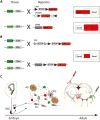Genetic approaches to access cell types in mammalian nervous systems
- PMID: 29471215
- PMCID: PMC5984678
- DOI: 10.1016/j.conb.2018.02.003
Genetic approaches to access cell types in mammalian nervous systems
Abstract
Understanding brain circuit organization and function requires systematic dissection of its cellular components. With vast cell number and diversity, mammalian nervous systems present a daunting challenge for achieving specific and comprehensive cell type access-prerequisite to circuit analysis. Genetic approaches in the mouse have relied on germline engineering to access marker-defined cell populations. Combinatorial strategies that engage marker intersection, anatomy and projection pattern (e.g. antero-grade and retro-grade viral vectors), and developmental lineage substantially increase the specificity of cell type targeting. While increasing number of mouse cell types are becoming experimentally accessible, comprehensive coverage requires larger coordinated efforts with strategic infrastructural and fiscal planning. CRISPR-based genome editing may enable cell type access in other species, but issues of time, cost and ethics remain, especially for primates. Novel approaches that bypass the germline, such as somatic cell engineering and cell surface-based gene delivery, may reduce the barrier of genetic access to mammalian cell types.
Copyright © 2018 Elsevier Ltd. All rights reserved.
Figures



References
Publication types
MeSH terms
Grants and funding
LinkOut - more resources
Full Text Sources
Other Literature Sources

